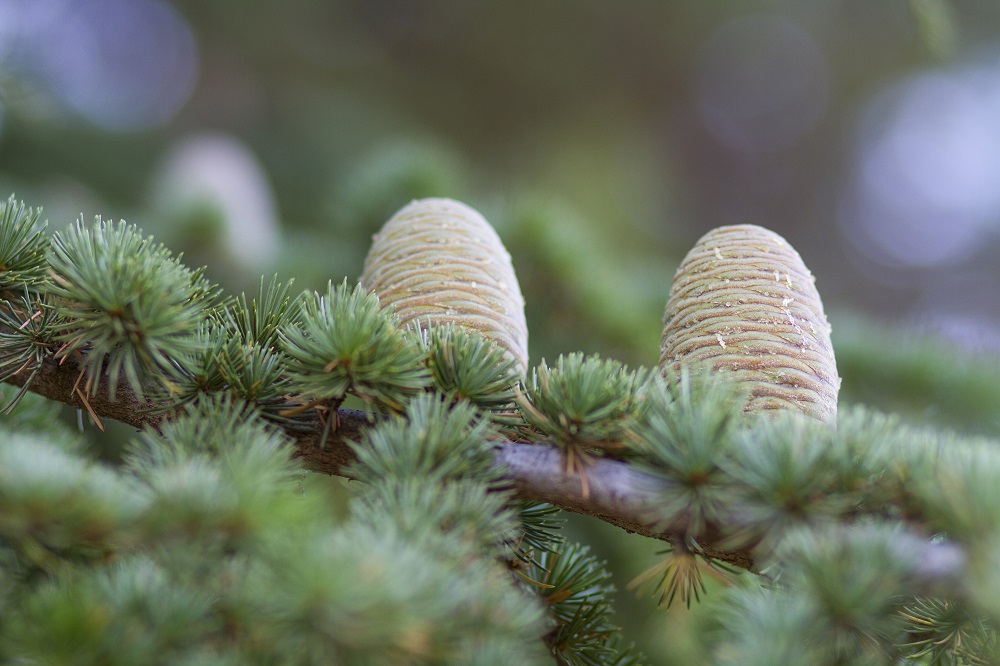Cedrus libani
Common Name:
Cedar of Lebanon

General Information:
This is a large stately evergreen, with a massive trunk when mature, and wide-sweeping, sometimes upright branches (more often horizontal) which originate on the lower trunk. Dark green needles and cones, which are held upright above the foliage, add to the impressive appearance. Young specimens retain a pyramidal shape but the tree takes on a more open form with age. Like most true cedars, it does not like to be transplanted, and prefers a pollution-free, sunny environment.
The Cedar of Lebanon is originally from the Middle East and grows to be a 40 - 50 feet tall tree in nature. The needles are short (1/2 to 1 inch) and grow in tufts along the branches. Cedars of Lebanon are widely used as an ornamental and are often found growing near the foundations of old homesteads.
Cedar of Lebanon is one of only four species (not including cultivars) of true cedars. The others are Atlas cedar C. atlantica, Deodar cedar C. deodara and Cyprus cedar C. brevifolia. Most other “cedars” are of the Juniperus, Chamaecyparis, or Thuja genera.
Family:
Pinaceae
Lighting:
Full sun.
Temperature:
Zones 5B through 10A. Watering: Has a high drought tolerance.
Feeding:
Simon and Schuster’s recommends feeding once a month with a slow-acting organic fertilizer during the growing season. If you prefer to use chemical fertilizers, feed every other week with a half-strength solution of a balanced fertilizer, such as Peter’s 20-20-20.
Pruning and wiring:
Basic pruning and positioning of the roots should be done at the time of initial potting and branch selection. The root system should be reduced gradually, so that there is always a good set of feeder roots.
To develop the foliage, pinch the new shoots (candles) with your ringers, leaving about one third of the shoot. Wiring is best done in the fall, but can be done in summer and should be avoided in spring. Wire can be left on for up to a year, but you should watch closely for any sign of wire cutting into the bark.
Propagation:
No information available.
Repotting:
Every 3-5 years in spring. May also be repotted at the end of summer or beginning of autumn, as the roots undergo renewed growth at that time. Simon and Schuster’s recommends 70% soil, 20% coarse sand, and 10% peat. Rémy Samson recommends 1 part leaf mould, 1 part loam and 1 part coarse sand. Cedars need good drainage, since they do not tolerate wet soil. If the tree gets a lot of rain, tip the pot slightly to encourage drainage. Use a deep bonsai pot, either unglazed or a glazed earth colour.
Place the tree where it will get good air circulation, but will be protected from wind, especially young trees and newly repotted trees.
Conifers grow in association with a symbiotic fungus which grows in the root ball of the tree. If this fungus is not present, the tree may die. For this reason, pines and other conifers should never be bare-rooted, unless steps are taken to re-introduce the fungus to the repotted plant, such as making a slurry (thin mud) of the old soil and pouring it over the newly potted soil.
Some experts feel that it is more important to be sure that the tree always has a healthy root system with sufficient feeder roots than to worry about symbiotic fungi. They feel that trees are more likely to die from having their root systems reduced too much at once than from not having the fungus present. Certainly it is good advice in any case to be sure the tree has sufficient roots.
Pests and diseases:
No pests or diseases are of major concern.
Bibliography:
USDA Fact Sheet ST-136
Compiled by Sabrina Caine
Edited by Michael Johnson and Thomas L. Zane
